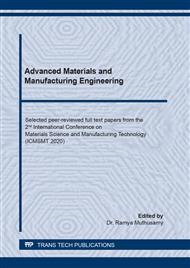[1]
M. Mozetiˇ, Plasma-Induced Crystallization of TiO2 Nanotubes, (n.d.). https://doi.org/10.3390/ma12040626.
Google Scholar
[2]
M.G. Necula, A. Mazare, R.N. Ion, S. Ozkan, J. Park, P. Schmuki, A. Cimpean, Lateral spacing of TiO2 nanotubes modulates osteoblast behavior, Materials (Basel). 12 (2019). https://doi.org/10.3390/ma12182956.
DOI: 10.3390/ma12182956
Google Scholar
[3]
T.M. Serikov, N.K. Ibrayev, Effect of fluoride and water content on the growth of TiO2 nanotubes synthesized via ethylene glycol with voltage changes during anodizing process Effect of fluoride and water content on the growth of TiO2 nanotubes synthesized via ethylene glycol with v, (2015). https://doi.org/10.1088/1742-6596/614/1/012001.
DOI: 10.1088/1742-6596/614/1/012001
Google Scholar
[4]
M. Kulkarni, K. Mrak-Poljšak, A. Flašker, Fabrication of TiO2 nanotubes for bioapplications, Mater. Tehnol. 49 (2015) 635–637. https://doi.org/10.17222/mit.2014.152.
DOI: 10.17222/mit.2014.152
Google Scholar
[5]
Z. Peng, J. Ni, Surface properties and bioactivity of TiO2 nanotube array prepared by two-step anodic oxidation for biomedical applications, R. Soc. Open Sci. 6 (2019). https://doi.org/10.1098/rsos.181948.
DOI: 10.1098/rsos.181948
Google Scholar
[6]
H. Wei, Synthesis and Photocatalytic Activity of One- Dimensional CdS @ TiO2 Core-Shell Hetero- structures, 3 (2011) 6–11.
Google Scholar
[7]
L.M.A. Monzon, J.M.D. Coey, Magnetic fields in electrochemistry: The Lorentz force. A mini-review, Electrochem. Commun. 42 (2014) 38–41. https://doi.org/10.1016/J.ELECOM.2014.02.006.
DOI: 10.1016/j.elecom.2014.02.006
Google Scholar
[8]
B.M. Rao, A. Torabi, O.K. Varghese, Anodically grown functional oxide nanotubes and applications, MRS Commun. 6 (2016) 375–396. https://doi.org/10.1557/mrc.2016.46.
DOI: 10.1557/mrc.2016.46
Google Scholar
[9]
L. Shi, H. Xu, X. Liao, G. Yin, Y. Yao, Z. Huang, X. Chen, X. Pu, Fabrication of two-layer nanotubes with the pear-like structure by an in-situ voltage up anodization and the application as a drug delivery platform, J. Alloys Compd. 647 (2015) 590–595. https://doi.org/10.1016/j.jallcom.2015.06.015.
DOI: 10.1016/j.jallcom.2015.06.015
Google Scholar
[10]
Y. Parcharoen, P. Termsuksawad, S. Sirivisoot, Improved Bonding Strength of Hydroxyapatite on Titanium Dioxide Nanotube Arrays following Alkaline Pretreatment for Orthopedic Implants, 2016 (2016).
DOI: 10.1155/2016/9143969
Google Scholar
[11]
P. Roy, S. Berger, P. Schmuki, TiO2 nanotubes: Synthesis and applications, Angew. Chemie - Int. Ed. 50 (2011) 2904–2939. https://doi.org/10.1002/anie.201001374.
DOI: 10.1002/anie.201001374
Google Scholar
[12]
N.H.A. Barudin, S. Sreekantan, O.M. Thong, L.K. Lay, Studies of cell growth on TiO2 nanotubes, Adv. Mater. Res. 620 (2013) 325–329. https://doi.org/10.4028/www.scientific.net/AMR.620.325.
DOI: 10.4028/www.scientific.net/amr.620.325
Google Scholar
[13]
H. Yang, X. Qin, A. Tian, D. Zhang, X. Xue, A. Wu, Nano size effects of TiO2 nanotube array on the glioma cells behavior, Int. J. Mol. Sci. 14 (2013) 244–254. https://doi.org/10.3390/ijms14010244.
DOI: 10.3390/ijms14010244
Google Scholar
[14]
H. Yin, H. Liu, W.Z. Shen, The large diameter and fast growth of self-organized TiO2 nanotube arrays achieved via electrochemical anodization, 21 (2010) 1–7. https://doi.org/10.1088/0957-4484/21/3/035601.
DOI: 10.1088/0957-4484/21/3/035601
Google Scholar
[15]
J. Wang, H. Li, Y. Sun, B. Bai, Y. Zhang, Y. Fan, Anodization of Highly Ordered TiO2 Nanotube Arrays Using Orthogonal Design and Its Wettability, 11 (2016) 710–723.
Google Scholar
[16]
S. Swain, T.R. Rautray, R. Narayanan, Sr, Mg, and Co substituted hydroxyapatite coating on TiO2 nanotubes formed by electrochemical methods, Adv. Sci. Lett. 22 (2016) 482–487. https://doi.org/10.1166/asl.2016.6888.
DOI: 10.1166/asl.2016.6888
Google Scholar
[17]
T. Sarkar, K. Gopinadhan, J. Zhou, S. Saha, J.M.D. Coey, Y.P. Feng, T. Venkatesan, Electron Transport at the TiO2 Surfaces of Rutile , Anatase , and Strontium Titanate : The Influence of Orbital Corrugation, (2015). https://doi.org/10.1021/acsami.5b06694.
DOI: 10.1021/acsami.5b06694
Google Scholar
[18]
K. Indira, U.K. Mudali, N. Rajendran, In-vitro biocompatibility and corrosion resistance of strontium incorporated TiO2 nanotube arrays for orthopaedic applications, J. Biomater. Appl. 29 (2014) 113–129. https://doi.org/10.1177/0885328213516821.
DOI: 10.1177/0885328213516821
Google Scholar
[19]
Z. Gorgin Karaji, B. Houshmand, S. Abbasi, S. Faghihi, Electrochemical anodic oxidation process of porous titanium granules for biomedical applications, Sci. Iran. 22 (2015) 2745–2751.
Google Scholar
[20]
Y.G. Ko, K. Hamad, Annealing behavior of 6061 Al alloy subjected to differential speed rolling deformation, Metals (Basel). 7 (2017). https://doi.org/10.3390/met7110494.
DOI: 10.3390/met7110494
Google Scholar
[21]
S. Vetrivel, R. Narayanan, Experimental investigation on corrosion behavior of rolled AA6061, Mater. Today Proc. (2019). https://doi.org/10.1016/J.MATPR.2019.11.280.
Google Scholar
[22]
F. Hilario, Influence of morphology and crystalline structure of TiO2 nanotubes on their electrochemical properties and apatite-forming ability, (2017). https://doi.org/10.1016/j.electacta.2017.05.160.
DOI: 10.1016/j.electacta.2017.05.160
Google Scholar
[23]
C.M. Ramos-Tonello, P.N. Lisboa-Filho, L.B. Arruda, C.K. Tokuhara, R.C. Oliveira, A.Y. Furuse, J.H. Rubo, A.F.S. Borges, Titanium dioxide nanotubes addition to self-adhesive resin cement: Effect on physical and biological properties, Dent. Mater. 33 (2017) 866–875. https://doi.org/10.1016/j.dental.2017.04.022.
DOI: 10.1016/j.dental.2017.04.022
Google Scholar
[24]
O. Bilek, Z. Fohlerova, J. Hubalek, Enhanced antibacterial and anticancer properties of Se-NPs decorated TiO2 nanotube film, PLoS One. 14 (2019) 1–15. https://doi.org/10.1371/journal.pone.0214066.
DOI: 10.1371/journal.pone.0214066
Google Scholar


